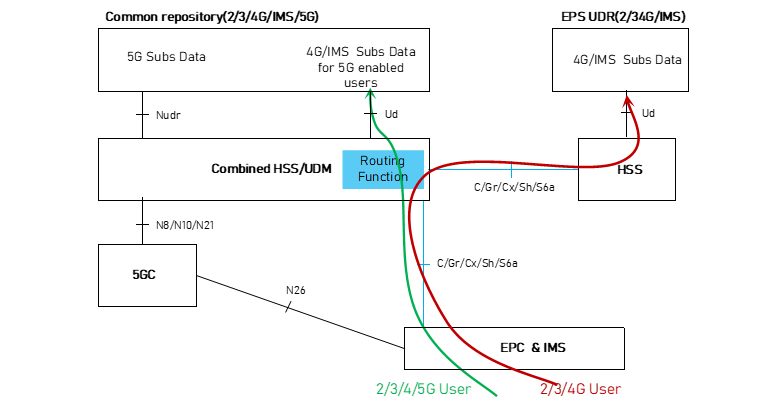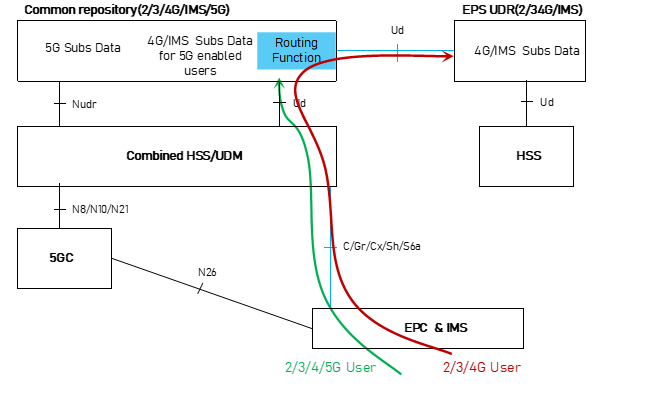The evolution from 4G to 5G cannot be achieved overnight. In the early stage and medium stage of 5G, due to the coverage problem, 2G/3G/4G network will coexist with 5G network for a long time. In addition, based on the service continuity requirement, the interoperability requirement between HSS and UDM are proposed. 3GPP analyzes the performance of the solution through the technical report TR23.732, and provides detailed solution specifications for one of the scenarios "HSS supporting service-based interface in the existing network" in TS 23.632.
3GPP provides multiple optional solutions but does not cover all possible solutions. During actual deployment, the operator may select more flexible and optimized transition solutions out of TS 23.632 based on its actual conditions.
Views of 3GPP
To minimize the impact on the existing network, the following two 3GPP TR 23.732 solutions are most likely to be implemented.

Figure 1 UDM/HSS FE Interaction Reusing Legacy Protocols, TR 23.732
In this solution, only the UDM function is expanded, and the UDM is disguised as MME/CSCF/AS to interconnect with the HSS through existing interfaces. The difficulty is that the UDM service logic is complicated. Because the storage is separated from each other, it easily causes the inconsistency between 5G service profile and 4G service profile of the same user.

Figure 2 Deployment and Coexistence without Interworking between UDM and Existing HSS, TR 23.732
This solution ensures that the 2G/3G/4G/5G profiles of a user exist in the same UDR database through the service provisioning system, thus avoiding the requirement for data access across HSS and UDM/HSS. Meanwhile, through the routing function in the network (implemented by the DRA/STP equipment), this solution solves the signaling routing problem between the two HSSs. The difficulty is that it is necessary to reconstruct the service provisioning system, and at the same time, the STP/DRA needs to add route information for 5G users, which requires high equipment capacity.
Practices in the Industry
Combining the advantages of the above two solutions, the industry proposes another feasible evolution solution: the Relay solution to optimize and supplement the existing evolution solution:

Figure 3 Relay Solution
- Solution Features:
− It inherits the "Deployment and Coexistence without Interworking between UDM and Existing HSS" solution. When the 5G service is commissioned, the user migrates from HSS to UDM/HSS. For the migrated user who has registered in 5G, UDM/HSS implements zero-interaction with the existing network HSS.
− It inherits the solution of "UDM/HSS FE Interaction Reusing Legacy Protocols". UDM/HSS reuses the existing HSS interfaces. The services of 2G/3G/4G/5G converged users are processed directly in UDM/HSS. The services of non-5G users are processed by Relay in the existing HSS, and the requirements for the existing HSS equipment are reduced to zero.
- Solution Enhancement:
− The built-in routing function avoids the dependence on the external routing device (DRA/STP), and solves the capacity requirement of the DRA/STP, thus saving the user investment.
− Through the Relay message, the problem that authentication data cannot be migrated to the new Combined UDM/HSS/UDR during 5G commissioning is solved.
− The consistency of profiles between 2G/3G/4G and 5G is ensured by migrating profiles for 2G/3G/4G/5G of the same user to one UDR database.
− The combined UDM/HSS only transparently forwards service signaling, which solves the pain points of complex UDM service logic.
To implement the Relay solution, the device manufacturer provides two solutions based on different components to implement the Relay function:
- FE Relay Based Solution

Figure 4 FE Relay Solution
FE has a built-in Relay function. FE can automatically create the user's route information according to the user data record in its UDR, and route the service request of 2G/3G/4G only user to HSS in the existing network for processing. Relay of authentication signaling can also solve the difficulty that the business commissioning system cannot transfer the authentication information from HSS in the existing network to new combined HSS/USM when the user has subscribed to 5G service.
- BE Relay Solution

Figure 5 BE Relay Solution
With the built-in Relay function of 5G BE (5GC UDR), 5G BE routes the data access request of the 2G/3G/4G Only user to EPS UDR (HSS BE) in the existing network for processing. This solution requires the implementation of the unified Ud interfaces on both existing and new UDRs, and 5GC UDR has to be compatible with the existing EPS UDR data storage solution. The interconnection is challenging, hence it is commonly applicable for interconnection between UDRs from the same vendor.
Summary
The evolution of user data from 4G to 5G has multiple paths, and each solution has its own optimal conditions. Operators need to select proper evolution solutions in accordance with their own network conditions and policies.
Compared with other solutions, the Relay solution is an excellent one. By using the interfaces of existing HSS for service processing, the solution avoids changes to existing HSS devices, and meets users' requirements for smooth evolution from 4G to 5G.
ZTE supports AI with full-stack IT offering
5GC Green Engine Solution to Enable Green Internet of Everything in the Dual-Carbon Era
5GC Private Network 2.0 Empowerment and Efficiency Improvement Boosts High-Quality Development of the Industry
5G Empowers Intelligent Mining for High-quality Development of Shaanxi Coal Caojiatan Mining
ZTE and China Mobile embrace digitalization for biodiversity conservation in Panda Reserve
Three Aspects Contribute to ZTE’s Remarkable Breakthroughs in Advanced G4X Server
How 5G Private Networks Are Poised to Transform Enterprises Worldwide: All Scenario Private 5G Helps Operators to Realize Private 5G as a Service
ZTE’s commitment to servers generates robust growth of up to 60 times in past 8 years
ZTE eyes top 5 global server market share
Full-Scenario One-Stop 5G Private Network for Vertical Industries

